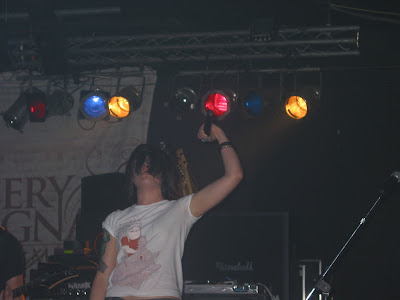Tonight in my photography course we worked to develop our very first roll of film. I wasn’t sure if I was going to make it through tonight. There weren’t enough dark rooms for everyone, so the teacher had me remove my film in a bag. Basically it was a black plastic back with arm holes so I could removed the film from the canister, thread the film onto a spool, and place it in a developing tank. Well, it took me forever to open the canister (the plastic tip end wouldn’t come off in one piece, so I had to work at it for a while). After that, I had a hard time getting the film threaded onto the spool. That was no fun. In due course a dark room became available. I was able to get the film, spool, and tank out of the bag in the dark room. After a few more minutes of trying, I finally got the film onto the spool and into the tank. All told that process, which should have been less than 5 minutes, took me a little over 15. To help soothe my bruised ego, the teacher did tell me that using the bag can be a little more difficult and usually takes a little practice before everything runs smoothly.
The chemical portion was more tedious than anything else. After I put the film through the fixer, I had 24 developed negatives. One bad thing did happen during the film extraction from the canister – in the process of removing the plastic, I ended up nicking three of the pictures. After photo-flo and drying, I now have 24 negatives. On Thursday we are going to make a contact sheet and prints.
That being the case, I went through some more of my South Carolina photos. Here are some more I think you’ll enjoy.

Aperture: f/1.8
Shutter Speed: 1/640
ISO100 with 0ev
Focal Length: 50mm

Aperture: f/22
Shutter Speed: 1/4
ISO100 with 0ev
Focal Length: 50mm
Both the above photos are of Hooker Falls in the Dupont State Forest in North Carolina. I decided to see what I could do if I slowed down the shutter speed from the original (in the top) to the point where motion could be seen. The effect was immediately obvious. The waterfall itself goes from being suspended water drops to constant streams. The water surface in the second photo is a lot more smooth. Since the wind was almost non-existent this day, slowing the shutter speed to 1/4 had a negligible effect on keeping the leaves in focus.

Aperture: f/2.8
Shutter Speed: 1/500
ISO100 with 0ev
Focal Length: 17mm
This is the pool directly in front of Hooker Falls.

Aperture: f/5.6
Shutter Speed: 1/160
ISO100 with 0ev
Focal Length: 50mm
This is Triple Falls in the Dupont State Forest in North Carolina. This is just upstream from Hooker Falls.

Aperture: f/8
Shutter Speed: 1/125
ISO100 with 0ev
Focal Length: 50mm
This is Green River Road at the Cowpens Battlefield in South Carolina near Spartanburg. The battle was part of the Southern Campaign during the American Revolution and fought by troops under the command of General Daniel Morgan. Where I was standing to take this picture was around the area where the Washington Light Cavalry (not associated with General George Washington) was stationed in the order of battle. This battle was significant in that it demonstrated one of the few successful double envelopments in the history of the warfare. What makes this even more impressive is the fact that the double envelopment was performed by an inexperienced general (Gen. Morgan) against Colonel Banstre Tarelton, a pupil of General Lord Cornwallis (known as a military genius of his time). To give perspective, the most notable use of double envelopment was by Hannibal in his defeat of the Romans at Cannae in 216BC.

Aperture: f/3.5
Shutter Speed: 1/2000
ISO100 with 0ev
Focal Length: 27mm
This is the monument in front of the Visitor’s Center at the Cowpens Battlefield National Park near Spartanburg, SC. The plaque lists the key officers involved in the battle on the side of the Continentals. The inscription on the side reads as follows: “The Congress of the United States has caused this monument to be erected on the site of the Battle of Cowpens as a testimonial to the valor and in appreciation of the services of the American troops on this field in behalf of the independence of their country”
The best part of the photos is this – in all cases I did not need to adjust the exposures. In all the above photos, save one, the only processing done was to increase the saturation (I’m still struggling a little with setting proper white balance). The monument photo required just a little bit of straightening as it was crooked by about 2-degrees.
Let me know what you think.























